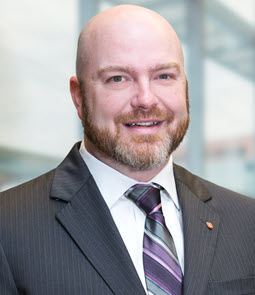

Patrick Gerstner, P.E., M.ASCE, is an associate vice president based in Dewberry’s Mechanicsburg, Pennsylvania, office. With nearly 30 years of experience, his background includes developing preliminary and final roadway designs for the Pennsylvania Department of Transportation and the Pennsylvania Turnpike Commission.
In this Member Voice article, Gerstner reveals the best career advice he ever received.
Oct. 4, 1993: my first day working as a professional.
I had graduated from college and gotten a job as an entry-level engineer in the highway group of Capital Engineers, which was subsequently acquired by Dewberry, my current employer. The transportation manager at the time was Carl Spataro, and the day I started, he invited me into his office to discuss responsibilities and expectations. While I may not recall everything he told me that day, there is one thing that has stuck with me ever since: “Bring a pad and pencil with you to every meeting.” A simple enough concept, but you would not believe the number of meetings where someone shows up without a pad and pencil – or any notetaking device – and ends up asking to borrow something to take notes or tries to remember everything that is said.
I’ll admit, my short-term memory isn’t the greatest. But even if it were, there are so many times that I have referenced my notes to verify the direction that I had received, to find documentation of decisions that were made, or to help resolve a disagreement with others.
Fast-forward a decade or so and I am a project manager. One of my responsibilities was to work with entry-level highway engineers. In the first meeting I had with each of them, I took note of whether they had a pad and pencil with them. If they didn’t, I asked them to go get these, and then proceeded to tell them what I am about to tell you: there are so many times that you will want to record something. This something could be project-related, general information associated with work benefits, contact information for people you meet, or other things. In every case, having documentation of this information will help when you need to recall it.
As I continued to advance in my career, I developed additional ideas about notetaking through my own personal experiences or through things I observed others doing.
Manage your information by dedicating a separate pad to each topic
I always kept a separate pad for each project for which I had responsibilities. This allowed me to reference information more easily without having to go through a stack of pads that were strictly a chronological list of all my notes.
Keep a small notebook so you can easily take it with you when you attend social or professional events. This allows you to take notes from a speaker or record nuggets of information that may come through during face-to-face networking.
Develop action items
I have found that your day can become overrun with meetings, going from one to the next without a break in between. Responsibilities are often assigned at meetings, and it is helpful to document these at the end of each meeting. Document action items for yourself and for others not only to identify the action items but to document when they have been completed. Many journals are formatted with a section for action items – use it.
Record meeting attendees
Documenting a decision is helpful, but often the person to whom a decision is attributed is equally important. Record attendees at meetings and jot down who provided direction or decided in your notes.
Write meeting minutes
Meeting minutes are best prepared while the information is fresh in your mind. In my experience, procrastinating in preparing meeting minutes is never fruitful. Take time shortly after a meeting to review your notes and prepare the meeting minutes. If you are the person responsible for running a meeting, it is a good idea to have a separate notetaker to capture everything, as it is hard to run a meeting and take complete notes. For me, the best method is to have another engineer who is knowledgeable of the project to sit in the meeting, take notes, and prepare the first draft of the meeting minutes. I then review the minutes and make additions or clarifications as necessary.
Notetaking for all phases of your career
As time went on, I was promoted to highway department manager and my responsibilities increased. I was responsible for managing the department as well as participating in marketing. Both responsibilities required my attendance at weekly meetings and notetaking.
At the peak, I had separate pads (tablets or journals) for upwards of 10 active projects, staff meetings, marketing meetings … highway department notes, client marketing meeting notes, and others for miscellaneous items. Having more than 15 journals may seem like a lot, but it is also an indication of how difficult it would be to track down information if everything was jumbled together.
Times have changed and many things are different now, but I still find that carrying a pad and pencil is crucial to documenting the many decisions, questions, and guidance that is provided during discussions. I have transitioned to using an electronic tablet with a stylus as my preferred method of taking notes for projects and typical office meetings. This allows me to access my notes from multiple devices and share the notes with others electronically. I use my phone to take notes when I am at social events. Regardless of the method, the concept remains the same. I take notes, and I refer to them. And the older I get, the more I refer to them.



